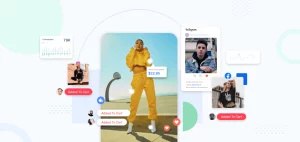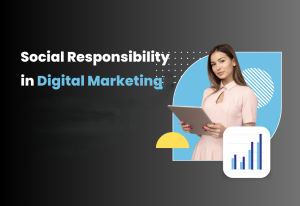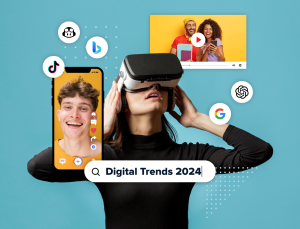Introduction Digital marketing and content creation are evolving at a rapid pace, especially with the advent of new technologies and shifting consumer behaviors. As we step into 2024, it’s crucial for businesses to stay ahead of the curve by understanding and adopting the latest trends. This article will explore 8 key digital marketing and content
Introduction
Digital marketing and content creation are evolving at a rapid pace, especially with the advent of new technologies and shifting consumer behaviors. As we step into 2024, it’s crucial for businesses to stay ahead of the curve by understanding and adopting the latest trends. This article will explore 8 key digital marketing and content trends expected to dominate in 2024, providing insights into how companies can leverage these trends to boost their digital presence.
The Role of Digital Marketing in Business Growth

Image by: Yandex.com
In today’s digital world, marketing plays a crucial role in driving business growth. Through online channels such as social media, websites, and search engines, businesses can increase their visibility and attract new customers. Digital marketing allows companies to build stronger relationships with their audience by providing relevant and timely content. It also helps businesses measure their performance, track conversions, and improve their strategies, ultimately leading to higher sales and long-term growth.
Top 8 Digital Marketing & Content Trends
1. AI-Driven Content Creation

Image by: Yandex.com
Artificial Intelligence (AI) is revolutionizing digital marketing and content creation. In 2024, we will see AI tools becoming even more advanced, capable of generating highly relevant and personalized content at scale. These AI-driven tools can analyze vast amounts of data to understand consumer preferences, predict trends, and create content that resonates with the target audience.
Why It Matters:
AI can help businesses streamline content production, enhance creativity, and ensure that the right message reaches the right audience at the right time. It also allows marketers to optimize their content strategy in real-time, making it more agile and responsive.
2. Video Content Continues to Dominate

Image by: Yandex.com
Video content has been a powerful tool for marketers for several years, but in 2024, its importance is expected to reach new heights. With platforms like TikTok, Instagram, and YouTube continuing to grow, businesses need to focus on producing short, engaging video content.
Why It Matters:
Video content is proven to drive higher engagement and conversion rates. Consumers are more likely to interact with videos than static images or text. Additionally, video allows businesses to tell compelling stories, showcase products, and build a deeper connection with their audience.
3. Voice Search Optimization

Image by: Yandex.com
With the rise of voice-activated devices like smart speakers and mobile assistants, voice search has become a key component of digital marketing. In 2024, businesses will need to optimize their content for voice search to remain visible in search results.
Why It Matters:
Voice search is changing the way consumers search for information online. Optimizing content for voice search involves using natural language and long-tail keywords. This can help businesses rank higher in search engine results and connect with a broader audience.
4. Personalization at Scale

Image by: Yandex.com
Consumers expect personalized experiences when interacting with brands online. In 2024, businesses will increasingly use data and AI to deliver highly personalized content and marketing campaigns. Personalization at scale means tailoring content to individual preferences, behaviors, and demographics.
Why It Matters:
Personalized content drives better customer engagement and loyalty. When customers feel that a brand understands their needs and preferences, they are more likely to make a purchase and become repeat customers.
5. Interactive and Immersive Content

Image by: Yandex.com
Interactive and immersive content, such as quizzes, polls, and virtual reality (VR) experiences, will continue to gain traction in 2024. This type of content allows consumers to engage more deeply with a brand and provides a more memorable experience.
Why It Matters:
Interactive content can increase user engagement and time spent on a website or platform. It also provides valuable insights into consumer preferences, which can be used to further personalize marketing strategies.
6. Social Commerce

Image by: Yandex.com
Social media platforms are increasingly integrating e-commerce features, allowing users to shop directly within the apps. In 2024, social commerce is expected to grow, with brands using platforms like Instagram, Facebook, and TikTok to drive sales.
Why It Matters:
Social commerce enables businesses to reach consumers where they already spend a significant amount of time. It provides a seamless shopping experience, making it easier for users to discover and purchase products without leaving their social media apps.
7. Sustainability and Social Responsibility in Content

Image by: Yandex.com
As consumers become more environmentally conscious, brands are being called to demonstrate their commitment to sustainability and social responsibility. In 2024, content that highlights a brand’s eco-friendly initiatives or social causes will resonate more with audiences.
Why It Matters:
Consumers are increasingly supporting brands that align with their values. By showcasing efforts toward sustainability and social responsibility, businesses can build stronger emotional connections with their audience and enhance their reputation.
8. Long-Form Content for Thought Leadership

Image by: Yandex.com
While short-form content is great for quick engagement, long-form content will continue to play a key role in building thought leadership. In 2024, businesses will focus on creating in-depth articles, eBooks, whitepapers, and case studies that provide valuable insights to their audience.
Why It Matters:
Long-form content establishes a brand as an authority in its industry. It provides a platform to share knowledge, solve problems, and showcase expertise, which can help build trust and credibility with consumers.
The Growth of Social Media Marketing
Social media marketing is a must-have for businesses in 2024. Platforms like Instagram, Facebook, and TikTok are more popular than ever. These platforms help brands talk directly to their customers using posts, stories, and ads. Social media lets businesses build a community, share news, and promote products in a fun and engaging way. It’s also great for targeting specific groups based on their likes and habits, making it a powerful way to reach the right people.
The Importance of Content Marketing

Image by: Yandex.com
Content marketing is still a powerful tool in 2024. By sharing helpful and interesting content, businesses can attract and keep customers. Blogs, videos, and infographics teach people new things and build trust. The goal is to solve customer problems and answer their questions, making the business a trusted expert. Good content also helps websites show up higher in search results, bringing more visitors and potential customers.
The Rise of Influencer Marketing
Influencer marketing is now a big part of digital marketing. Brands work with social media influencers who have many followers to promote their products. In 2024, this trend keeps growing. Businesses team up with influencers on platforms like YouTube, Instagram, and TikTok. Influencers have loyal fans who trust them, so their recommendations often work better than regular ads. This type of marketing helps businesses reach specific groups and build trust with real and honest reviews.
Mobile Marketing and its Impact

Image by: Yandex.com
Mobile marketing is very important in 2024. Many people use smartphones for shopping, social media, and browsing. Businesses need to make their marketing fit for mobile use. This means having mobile-friendly websites, creating ads for phones, and using apps to connect with customers. Mobile marketing also uses location-based ads. These ads send special offers based on where a customer is. As more people rely on their phones, mobile marketing will help businesses stay in touch with customers anytime, anywhere.
Challenges of Digital Marketing in 2024
Digital marketing has many benefits, but it’s not always easy. One big challenge is keeping up with new technology and changing customer needs. Businesses must adapt quickly when new tools and platforms appear. Another challenge is the competition. As more businesses go online, it’s harder to stand out. Companies need to be creative to grab attention. Managing large amounts of data and protecting privacy is also tricky.
The Future of Digital Marketing

Image by: Yandex.com
The future of digital marketing looks promising, with more advanced technologies expected to shape the way businesses interact with their customers. AI and machine learning will continue to improve content personalization, making marketing campaigns more effective. As consumers demand more convenience, voice search and social commerce will become even more important. Additionally, businesses will focus on creating more immersive and interactive experiences, such as through virtual reality (VR) and augmented reality (AR). By embracing these trends, businesses can continue to evolve and stay ahead in the digital world.
Analysis Table: Key Digital Marketing & Content Trends in 2024
| Trend | Key Focus | Benefits | Examples |
|---|---|---|---|
| AI-Driven Content Creation | Use of AI tools for personalized content | Increased efficiency, higher relevance in content | AI-based writing assistants, chatbots |
| Video Content Dominance | Short-form video on social media | Increased engagement, higher conversion rates | TikTok videos, Instagram Reels |
| Voice Search Optimization | Optimizing for voice search | Better search rankings, more natural user queries | Voice-optimized websites, podcasts |
| Personalization at Scale | Tailored content using data | Enhanced customer loyalty, higher engagement | Personalized email campaigns, website recommendations |
| Interactive Content | Quizzes, polls, VR experiences | Higher engagement, more data for personalization | Interactive product demos, VR showrooms |
| Social Commerce | Shopping directly through social media | Seamless shopping experience, increased sales | Instagram shop, Facebook marketplace |
| Sustainability in Content | Highlighting eco-friendly initiatives | Strengthened brand image, consumer trust | Sustainability blogs, green product promotions |
| Long-Form Thought Leadership | In-depth articles, whitepapers, case studies | Building authority, establishing brand expertise | Blog series, eBooks, industry reports |
Comparative Table: Traditional vs. Modern Digital Marketing Approaches
| Aspect | Traditional Marketing Approach | Modern Digital Marketing Approach |
|---|---|---|
| Content Format | Print ads, TV commercials, static images | AI-driven content, short-form and long-form videos, interactive content |
| Audience Targeting | Broad audience targeting, general demographics | Hyper-targeted campaigns, personalized content based on data and AI insights |
| Customer Engagement | One-way communication, limited interaction | Two-way communication, real-time feedback, social media interaction |
| Channel | TV, radio, print media | Social media, email, voice search, video platforms |
| Data Analytics | Basic metrics like sales and audience reach | Real-time data analytics, personalized metrics, AI-based insights |
| Budget | High-cost production (e.g., TV ads, print) | More cost-effective with content automation, social media ads, and AI tools |
| Branding | General branding messages, traditional storytelling | Authentic storytelling, sustainability focus, influencer partnerships |
| Sales Funnel | Linear, relying on traditional sales channels | Multi-touch, relying on content, social commerce, and interactive experiences |
Conclusion
As we move into 2024, digital marketing and content strategies are becoming more data-driven, interactive, and personalized. With AI, video content, voice search, and social commerce leading the charge, businesses must adapt to stay competitive. Additionally, focusing on sustainability and creating long-form, thought-leadership content will further strengthen brand loyalty and authority. By embracing these trends, businesses can build deeper connections with their audience, drive higher engagement, and achieve long-term success in the digital world.
















